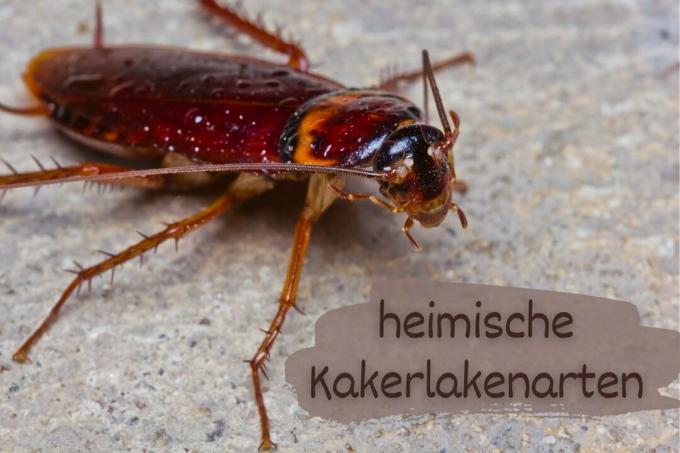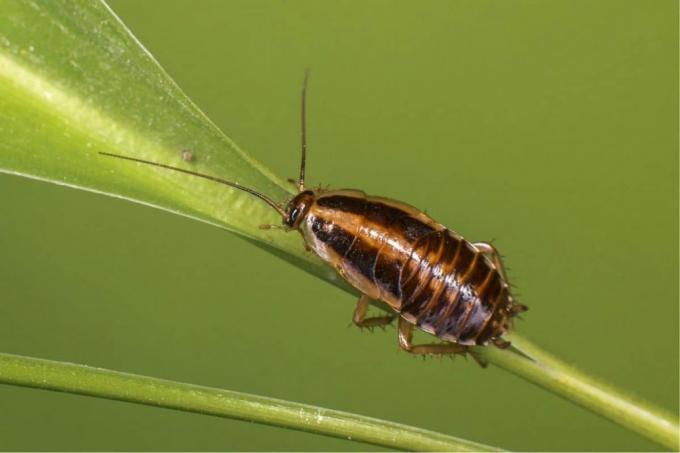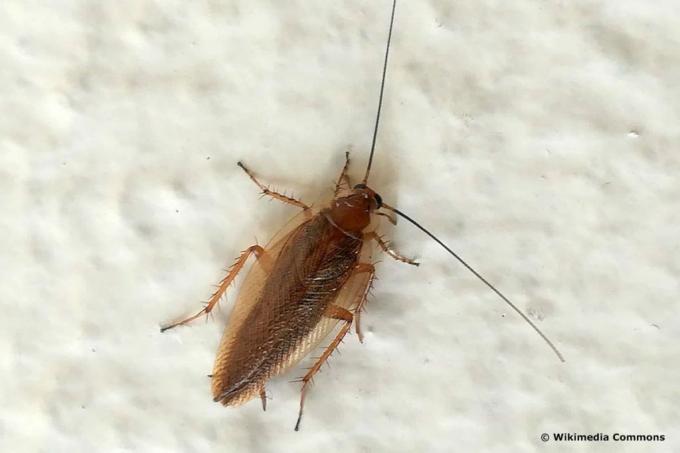
table of contents
- Cockroaches
- American cockroach (Periplaneta americana)
- Brown banded cockroach (Supella longipalpa)
- German cockroach (Blattella germanica)
- Common cockroach (Blatta orientalis)
- Forest cockroaches
- Amber wood cockroach (Ectobius vittiventris)
- Common wood cockroach (Ectobius lapponicus)
- frequently asked Questions
Cockroaches, also known as cockroaches, are a common pest in many countries. However, most of the approximately 4600 species occur primarily in the tropical and subtropical regions. In contrast, there are only six species of cockroach in Germany.
In a nutshell
- Differentiation between cockroaches and wood cockroaches
- only cockroaches are pests
- Cockroaches are often very sensitive to cold
- Wood cockroaches rarely found in apartments
- Cockroaches transmit dangerous diseases
Cockroaches
Cockroaches are those types of cockroaches that primarily live in close proximity to humans. live in human dwellings. The majority of these cockroaches are not native to Germany, but were (and are still) introduced from their warm home countries. They can only survive where it is warm enough: in apartments, bakeries, hotels, tropical houses, etc.
American cockroach (Periplaneta americana)
Contrary to what you might think, the American cockroach comes from Africa. From here this species of cockroach spread with shipping in all subtropical and tropical regions of the world. There it is one of the most common cockroach species. In Germany, the American cockroach was only found in zoos or botanical gardens for a long time. In the meantime, however, occasional copies are also in public in this country Facilities such as hotels, restaurants, in sewer systems, district heating shafts or Thermal power stations found. Since the species is extremely sensitive to cold, it cannot overwinter outdoors in Germany.

Appearance
- Color: red-brown, yellowish-red band in the rear area of the head shield
- Body length: up to 53 millimeters
- very long antennae, can be body-length or longer
- both sexes winged
- Wings reach to the tip of the abdomen
way of life
- can fly and climb well
- very fast runner
- predominantly nocturnal
- can survive without food for up to three months
- Laying the eggs in egg containers (oothecae)
- capsule-like, dark colored and approx. eight by five millimeters in size
Note: When laying eggs, the females usually attach the egg capsules, which contain around 15 to 20 eggs, near food, for example to packaging or pallets. This is how the American cockroach spreads all over the world through trade.
Brown banded cockroach (Supella longipalpa)
The brown banded cockroach also originally comes from Africa, and also spread through shipping and trade throughout the world. Unlike other types of cockroaches, this one prefers very warm (more than 27 ° C) and rather dry environments, which is why they are typically found in electrical devices, in computer systems, cable ducts, on hot water pipes, light switches as well as in and on picture frames and furniture are.

Appearance
- Color: red-yellow to red-brown, two light horizontal stripes on the pronotum
- Body length: females 10 to 12 millimeters, males up to 15 millimeters
- Males have pointed bodies
- Females have shorter, more rounded bodies
- well-developed wings in both sexes
way of life
- mostly nocturnal, but sighting possible during the day
- unable to fly despite wings
- Egg-laying in capsule-like egg cocoons (oothecae)
- often stored in cracks in furniture or floors
- Development is temperature dependent
- very sensitive to cold
Note: Since the brown band cockroach is not only distributed through food, but also through electrical appliances and (second-hand) furniture, it is also known under the name "furniture scraper".
German cockroach (Blattella germanica)
The full-winged German cockroach or domestic cockroach, which is also one of the most common pests here, is also found in buildings around the world. In Central Europe, this type of cockroach is mainly found in warm and humid rooms, such as those found in bakeries, large kitchens, canteens, hospitals, swimming pools or greenhouses. The cockroach also occurs frequently in private households if living conditions are suitable. Compared to other cockroach species, it is significantly less sensitive to cold: the animals are only unable to move around at temperatures below four degrees Celsius. Your egg capsules can even withstand freezing temperatures of up to 20 ° C.

Appearance
- Color: monochrome yellow-brown, 2 dark vertical stripes on the pronotum
- Body length: 10 to 15 millimeters
- well developed wings
way of life
- not airworthy despite wings
- only gliding possible
- can also overwinter outdoors
- in very warm places up to four generations per year
- Females lay up to 200 eggs
- Egg capsules light brown to brown in color
Common cockroach (Blatta orientalis)
The warmth in bakeries, large kitchens and other food establishments as well as the constant availability of food offer a true Eldorado for the oriental cockroach or cockroach. Baker's cockroach cockroach. Since this species comes into contact with bacteria and fungi of all kinds and spreads them so, their occurrence poses a major hygiene problem. The common cockroach cannot fly and is common in buildings around the world, with the exception of arctic and sub arctic regions. It is one of the most common types of cockroach in the world.

Appearance
- Color: dark brown to black
- Body length: females 22 to 30 centimeters, males 20 to 25 centimeters
- in males the fore wings do not quite reach the rear end
- stubby wings in females
- long, thread-like antennae
- has stink glands
way of life
- nocturnal and photophobic
- sensitive to cold, feels at temperatures from approx. 20 ° C most comfortable
- cannot climb well, so stays close to the ground
- Females lay up to 190 eggs
- egg capsules up to 10 millimeters long
- initially reddish in color, later black
Note: The cockroach can squeeze itself through the narrowest gaps, which is why even the smallest gaps in the walls should be closed when fighting. In addition, the species can no longer reproduce at temperatures below 15 ° C.
Forest cockroaches
Strictly speaking, forest cockroaches do not belong to the cockroach species, as only the cockroaches are called that. Nevertheless, both groups of species belong to the zoological order of cockroaches (Blattodea).
- both groups of species are closely related
- look very similar outwardly
- quite high likelihood of confusion
- Forest cockroaches are no pests
- rarely found in human proximity
- Habitat: forest floor
- Food: decaying plant matter and small animals
Amber wood cockroach (Ectobius vittiventris)
The amber forest cockroach, which immigrated from southern Europe, is only very rarely found in human dwellings. unable to survive there due to a lack of food. Anyone who lives near the forest in southern Germany sometimes becomes one thing in the evening when it gets dark or find other specimens that have strayed into the apartment - the animals are illuminated by artificial light dressed. The amber forest cockroach is also not one of the pests.

- Color: light brown, pale, translucent pronotum
- Body length: 9 to 14 millimeters
- well-developed wings in both sexes
- protrude from the apex of the abdomen
- Wings sometimes finely spotted
- both sexes airworthy
The amber forest cockroach is very similar in size and color to the German cockroach, but - in contrast to the pest - has no longitudinal stripes on the pronotum.
Note: Sometimes this species of cockroach also likes to nestle in the garden and is mainly to be found in low bushes or under pots.
Common wood cockroach (Ectobius lapponicus)
The native wood cockroach is widespread and can be found quite frequently in and on the herbaceous and soil layers of deciduous, mixed and coniferous forests as well as in parks, hedges and gardens. In contrast to other cockroaches, the species is diurnal, but also loves warmth. The male is able to fly with his well-developed hind wings, while the female has only stunted wings and only moves by crawling.

- black-brown coloration
- Pronotum and wings translucent
- Males with a dark pronotum
- 9 to 13 millimeters long
- Oblong-oval body
Note: The forest cockroach can be seen between May and October. In addition, there are other forest cockroaches in Central Europe that are very similar to this one.
frequently asked Questions
While nocturnal forest cockroaches are often attracted by artificial light and thus fly through the open window, they get there Pests mostly enter through contaminated food or food packaging, through second-hand furniture and the like Apartment. Occasionally, you bring them with you from vacation so that they can reproduce and spread at home with suitable living conditions. Some species also crawl into the house through crevices and cracks in the masonry.
With good reason, the cockroaches (not the forest cockroaches!) Are viewed and controlled as pests as they can transmit a variety of dangerous diseases. Cockroaches spread bacteria and other pathogens that cause dysentery, typhus, tuberculosis or salmonellosis, for example. In addition, the animals can transmit worm parasites and mold spores to humans, their excrement cause asthma and skin eczema.
Yes, since the majority of cockroaches are omnivorous, in theory they can also bite humans. However, they do this very rarely, as they tend to flee from us humans. It is possible that cockroaches bite in dangerous situations with no possibility of escape or when there is a lack of food or when there is a lack of food. a very strong infestation.
